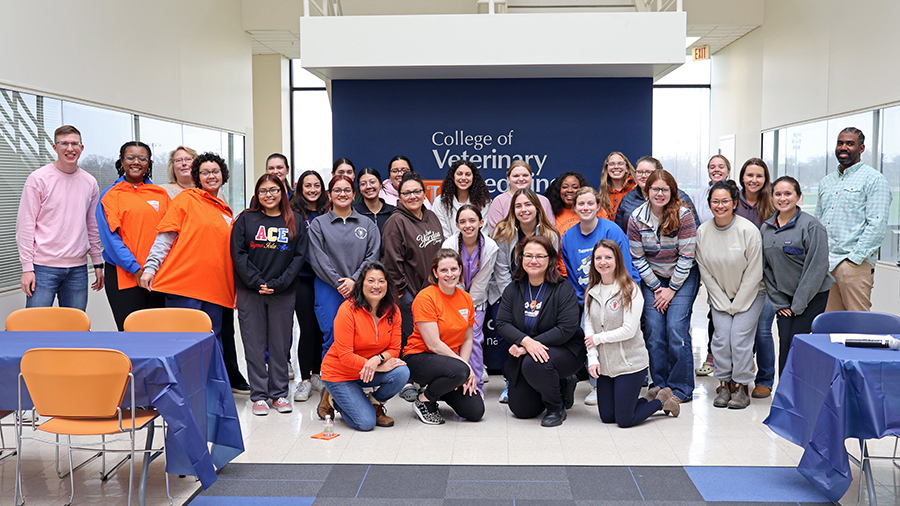Disease can be transmitted from wildlife to pets
“Zombie” raccoons are in the news again in Cook County. Called zombies because they stagger around and show abnormal behaviors, the raccoons are not undead but infected with a virus: canine distemper virus. This virus may infect a variety of wildlife, including coyotes, foxes, and skunks in addition to raccoons.
Unfortunately, as the name implies, the virus can also infect domestic dogs. The University of Illinois Zoological Pathology Program, which is based in Chicago, works closely with Cook County officials to monitor for canine distemper virus and alert the public of outbreaks.
Last December Dr. Karen Terio, the veterinary pathologist who heads the Zoological Pathology Program, notified the Cook County Department of Animal and Rabies Control of an uptick in cases of canine distemper detected through the wildlife surveillance program. Animal control officials then issued an alert to municipalities, veterinarians, and animal shelters to be on the lookout for possible cases of the virus in dogs. They also urged the public to vaccinate their pets because unvaccinated dogs can become infected and contract the disease.
The December outbreak has carried through to spring. Now that more people are outside in the warm weather, public officials have been receiving more notifications about infected raccoons. The news media are once again warning area dog owners of the dangers.
What Is Canine Distemper Virus?
Canine distemper is a highly contagious disease caused by paramyxovirus. It is a widespread disease that can affect wild and domestic carnivores.
Clinical signs of canine distemper virus are similar in both domestic dogs and wildlife. The signs can include coughing, sneezing, discharge from the eyes and nose, lethargy, vomiting, diarrhea, and abnormal behaviors or neurological signs. Canine distemper virus leads to abnormal behavior because the virus infects the brain.
It is vital to contact the local animal control if a wild animal is observed acting abnormally. Keep pets away from all wildlife, and especially avoid contact with potentially ill or infected wild animals.
Wildlife Disease Monitoring a Must
Many diseases can be transmitted between species, including between wildlife and humans or their pets. Monitoring wildlife diseases, therefore, is vital to ensuring public health and the health of pets.
The Zoological Pathology Program, a section within the Veterinary Diagnostic Laboratory at the University of Illinois College of Veterinary Medicine, specializes in diagnosis of disease in wild animals. The program’s partnership with Cook County Animal and Rabies Control and the Forest Preserve District of Cook County encompasses not only monitoring for disease but also providing information about animal ecology and behavior that gives context for the test results.
“When animal control officers are notified of a sick or dead wild animal, they will collect it and the animal is submitted to the Zoological Pathology Program for a necropsy,” Dr. Terio explains.
A necropsy is an animal autopsy that can help determine the cause of death and detect any additional illness. In the case of the species affected by canine distemper virus, the pathologists test the animal’s tissues for the presence of the virus and looks for other signs of disease.
“The information gained by monitoring and studying disease in wildlife allows us to alert public health and veterinary officials when we see evidence of an outbreak or something new entering our area,” says Dr. Terio.
“The canine distemper outbreak is a perfect example of the benefits of monitoring. Because Zoological Pathology Program is always looking at disease in wildlife, we were able to identify an increase in cases that prompted the initial alert and get the word out to prevent spillover into pet dogs.”
Protecting Pets
It is possible for domesticated dogs to contract canine distemper virus from wildlife though direct contact, airborne transmission such as a sneeze, or objects such as food bowls left outside and used by many animals.
“The simplest way for pet owners to prevent the spread of distemper is by vaccinating their dogs for the canine distemper virus,” Dr. Terio advises. This can be done through the pet’s local veterinarian.
For further information about canine distemper virus or the vaccine, contact your local veterinarian.
By Beth Mueller

![[raccoon]](https://vetmed.illinois.edu/wp-content/uploads/2021/04/pc-terio-cdv-raccoon.jpg)


